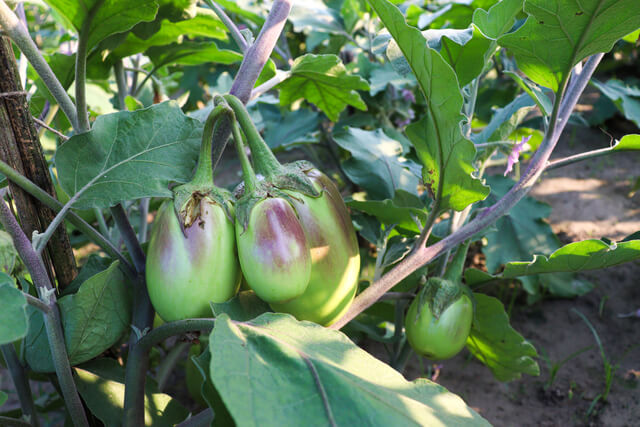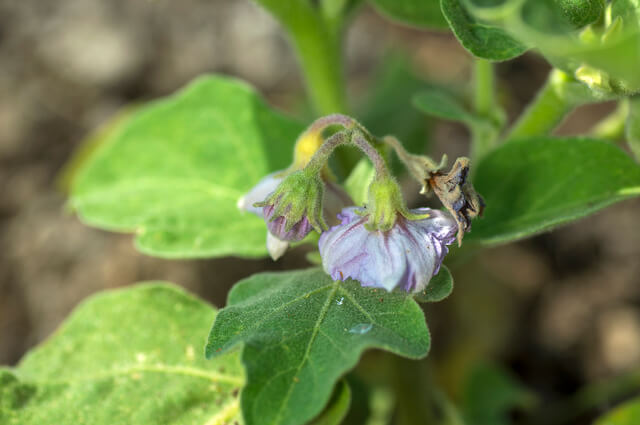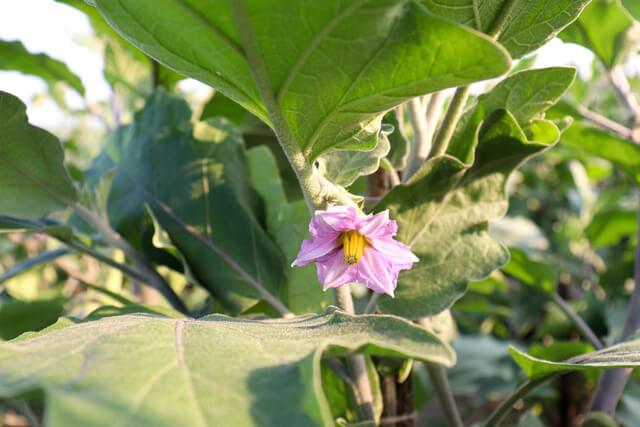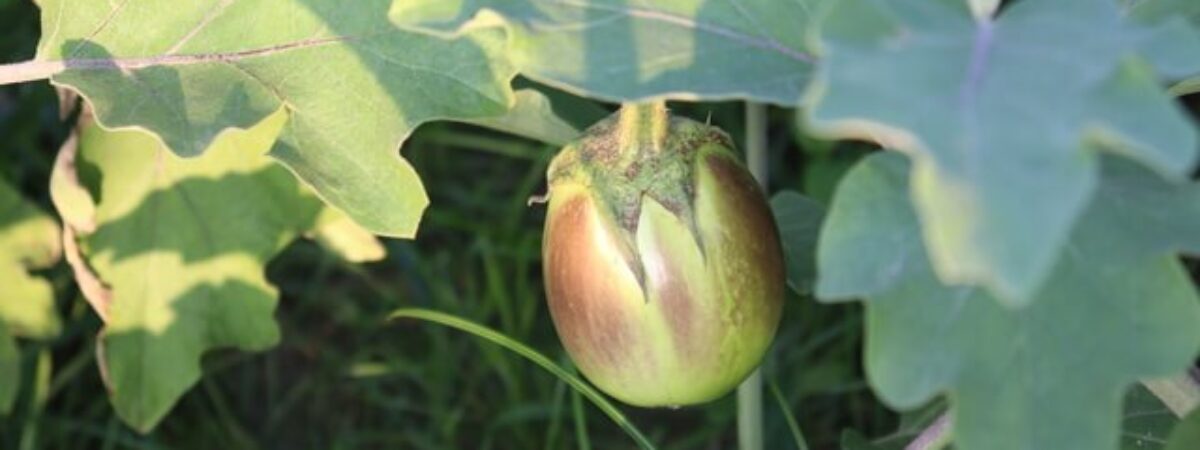Brinjal plant is scientifically called Solanum melongena that belongs to the Solanaceae family. Brinjal plant is also called Eggplant or aubergines. These are perennial vegetables that grow especially in warm conditions.
Brinjal plants originated from Asia and are warm season vegetables but these are grown as annuals in North America.
Brinjal plants are grown in USDA Hardiness zone 9-12. These are fast-growing vegetables. They come in a variety of colors like Purple, Green, and white.
Among them purple and green Brinjals are mostly grown and eaten worldwide. Some of the varieties of eggplant are so beautiful that they are even grown as ornamentals by many gardeners.
Brinjal plants can be grown in the ground as well as in containers/pots. In this article, a detailed guide on growing and caring of brinjal plants in ground as well in containers is given. Click To TweetBrinjal plants can be grown in the ground as well as in containers/pots. In this article, a detailed guide on growing and caring of brinjal plants in ground as well in containers is given.

Varieties of Brinjal Plant
‘Black Beauty’ -This variety is a traditional one that produces around 4 to 6 large round fruits.
‘Black Bell’- This variety is oval to round shaped with purple to black colored fruit; these are however resistant to diseases.
‘Dusky’- This variety is pear-shaped and has glossy purple fruit that impart excellent flavor and are resistant to diseases.
‘Fairy Tale’-This is a dwarf brinjal plant that grows upto 4 inches.
‘Hansel’- A long and narrow variety having few seeds.
‘Gretel’- This is a white skinned variety
Rosa Bianca’- A round brinjal with shades of pink and lavender
‘Little Fingers’- As the name suggests, these are small finger-like purple colored varieties. However these are heavy bearers.
‘Applegreen’- This variety is oval in shape that bears tender light green fruits.
‘Bambino’- This is also oval shaped and looks like walnut and has purple to black fruits.
‘Casper’: This variety is cylindrical in shape with snow white fruits and tastes like mushrooms.
‘Cloud Nine’-This variety is shaped as a teardrop having white and is resistant to diseases.
‘Kermit’- This variety possesses green fruits with white stripes and are of Thai types.
‘Rosita’- This variety has pear-shaped rose pink fruits that give a sweet taste.
‘Ichiban’- This variety bears purple to black thin fruits that can grow till frost. You can even get more than a dozen fruits from one plant.
‘Easter Egg’- This is a white color variety that is usually grown as an ornamental plant. These are non-edible.

Growing and Caring guide
Soil
Brinjal plants prefer loamy well drained soil that has high organic matter content. The ideal pH required for the growth is 5.5-7.5.
If you are growing your brinjal plant in pots then a soil mix that contains all the nutrients is ideal for their growth in containers/pots.
An ideal soil mix is a mixture of sand, fertile soil, compost and fertilizer containing Nitrogen, Phosphorus, Potassium in 5-10-5 grade, all in the ratio of 2:1:1.
Light
Brinjal plants require enough Sunlight for their growth. They basically need at least six hours of direct light.
If you are growing these plants in pots, then you need to watch their growth and according to that switch the place of your container.
If the growth is slow in shade then place the pot under the Sun and if the growth is slow under Sun then place the container in shade.
Water
These plants prefer moist soil to grow but overwatering will harm the plants. It is better to check the moisture level of soil before the next watering.
Mulching of the soil with straw and wood chips helps to retain moisture level. If you notice some abnormal shaped brinjals then it might have been caused due to irregular watering.
Temperature and Humidity
As you know eggplant is a warm season vegetable, so optimum temperature required for these plants to grow is between 70 degrees Fahrenheit to 90 degrees Fahrenheit.
During the night the temperature falls to 60 degrees Fahrenheit. They require medium humidity as high humidity can harm the pollination process.
Fertilizer
Brinjal plants are heavy feeders, so they require frequent fertilization. A good quality fertilizer that contains all the essential nutrients, NPK in the grades 5-10-5 is ideal.
You should fertilize at the time of planting the seeds and again when the plant is small. Brinjal plants need more phosphorus.
Spray the liquid fertilizer on the leaves of the plant for their healthy growth.A good quality compost is great for these plants as they grow best in organically rich soil.
Pollination
Basically Eggplants are self pollinated plants i.e wind pollination mostly occurs. However they can be pollinated by insects as well.
Harvesting
You can get the best taste of these brinjal plants when you harvest them at their young stage. Usually the brinjal is harvested after 65 to 80 days of planting.
However it totally depends upon the place you are living and the variety you are growing. Best harvesting months are July, August and September.
If you have transplanted the egg plants then it will take 65 to 80 days to get mature and if you have grown the plant from seeds then it will take 100 to 120 days for maturity.
A bit of an art is involved when harvesting fruits, so if they are picked when under-ripe or overripe, they can taste bitter.
A healthy fruit should have a glossy, smooth, uniform surface, and look unwrinkled. Its seeds should be soft but solid when you cut it open. Click To TweetA healthy fruit should have a glossy, smooth, uniform surface, and look unwrinkled. Its seeds should be soft but solid when you cut it open.
Dark and hard seeds inside the fruit will make it bitter if the skin looks faded. Use a sharp scissor or pruning shears to cut fruit from the stem just above the calyx on the top.
It is advisable to wear gloves while cutting brinjal as the calyx of these plants can be prickly.

Storage
Brinjal plants can be stored in humid conditions for 2 weeks where the temperature is not lower than 10 degree celsius. If kept in a fridge, you can enjoy the eggplant for many days.
Using a marinade of salt, vinegar, and/or lemon juice can prevent discoloration of eggplant after it’s been cut open for grilling or cooking.
Pests and Diseases
Brinjal plant is susceptible to many pests and diseases like other vegetables of the same family such as tomatoes.
Some of the pests and diseases are discussed below
Early Blight
The lower leaves develop dark concentric spots surrounded by yellow rings. It also affects the stems/roots of the plant.
The best way to control it is to grow resistant varieties, take out the infected plants from the field. Keep the soil fertile and allow good air circulation.
Powdery Mildew
Leaves become flour-like smeared over entire surfaces when white spots appear on upper leaves.
The best way to control it is to grow resistant varieties and spray plants with one cup of baking soda and one quart of water.
Blossom- end rot
This is often the result of roots that lack sufficient water and/or nutrients, as calcium is deficient in fruit.
Mulching and maintaining the soil pH 6.5 and nutrients. Avoid more nitrogen, keep the soil well drained.
Flea beetles
The leaves have numerous tiny holes, as if they had been hit by birdshot. Consider covering your plants with row covers, mulching heavily, and adding native plants with beneficial insects.
Conclusion
Now that you have come so far reading this guide on growing and caring of Brinjal plants or you can say Eggplant, you must have got some idea on how to grow and care for these plants efficiently.
I think you should definitely try growing Brinjal plants in your own backyard and get the benefit of these healthy vegetables.
It is a pleasure to grow and harvest these beautiful deep purple vegetables – one of everyone’s favorites to grill.
If you have any queries regarding growing and caring of the Brinjal plants then feel free to drop your questions in the comments below.
You may also like to read
Daikon Radish – How to Grow and Harvest
How to Grow Cauliflower? Start with Your Vegetable Garden at Home!






